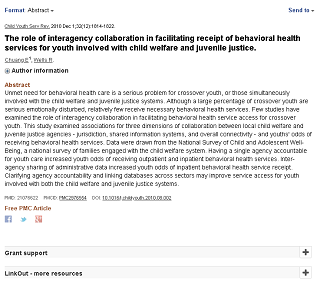-
Cross Systems Collaboration
Cross-System Collaboration
National Child Traumatic Stress Network (NCTSN)GeneralOutlines practice examples for continuity of care and collaboration across systems. Written by Macon Stewart from the Center for Juvenile Justice Reform- 2013
-
The role of interagency collaboration in facilitating receipt of behavioral health services for youth involved with child welfare and juvenile justice
Cross-System Collaboration
Child and Youth Services Review JournalGeneralE. Chuang & R. Wells (2010) Child Youth Serv Rev. 2010 December 1; 32(12): 1814–1822. doi:10.1016/j.childyouth.2010.08.002.
-
A systematic review of the effectiveness of interagency and cross-system collaborations in the United States to improve child welfare outcomes
Cross-System Collaboration
Children and Youth Services ReviewChild WelfareThis systematic review summarizes the effects of interagency and cross system collaboration to improve child welfare outcomes
-
Measuring Collaboration Across Children's Behavioral Health and Child Welfare Systems
Cross-System Collaboration
Brent CrandalGeneralA commonly emphasized component of trauma-informed care is the practice of building cross-systemcollaboration (CSC). While existing research on CSC states numerous benefits and barriers associatedwith increasing collaboration between systems, there is limited empirical understanding on how to defineand measure collaboration between county systems of care. The current study presents the psychometricevaluation of scores from the Perceptions of Overarching Cross-System Collaboration–Child Welfareand Behavioral Health Systems (POCSC-CW/BH), a 6-item self-report instrument completed by systemadministrative leadership and direct service providers, administered within child welfare and children’sbehavioral health systems in 6 California counties.
-
Child Welfare/Mental Health Learning Collaborative Toolkit
Cross-System Collaboration
California Social Work Education Center (CALSWEC)Child Welfare, Behavioral HealthThe Child Welfare/Mental Health Learning Collaborative Toolkit provides resources designed to assist county administrators and staff to implement integrated child welfare and mental health services for families and children participating in both systems.
-
Child Welfare/Mental Health Learning Collaborative Toolkit
Cross-System Collaboration
California Social Work Education Center (CALSWEC)Child Welfare, Behavioral HealthThe Child Welfare/Mental Health Learning Collaborative Toolkit provides resources designed to assist county administrators and staff to implement integrated child welfare and mental health services for families and children participating in both systems.
-
Desk Guide on Trauma-Informed Child Welfare for Child Mental Health Professionals
Cross-System Collaboration
Chadwick Trauma-Informed Systems Project (CTISP)Behavioral HealthThis 16-page guide plus pull-out insert is designed to assist mental health professionals in increasing their knowledge of the policies, practices, and culture of the child welfare system.
-
Trauma-Informed Workgroup Meeting Guidelines
Cross-System Collaboration
Trauma Informed OregonGeneralThis set of guidelines, provide structure for creating a trauma informed care workgroup and is applicable to development of a cross-system workgroup.
-
Building a Multi-system Trauma-Informed Collaborative
Cross-System Collaboration
Chapin Hall at the University of Chicago and American Institutes for Research: Jason Brennen, Jennifer Axelrod, Kathleen Guarino, Simon GonsoulinGeneralThis guide offers a framework for system-level and cross-system strategic planning and implementation processes for supporting trauma-informed systems change across child-serving systems.
-
Child Welfare/Mental Health Learning Collaborative Toolkit
Cross-System Collaboration
California Social Work Education Center (CALSWEC)Child Welfare, Behavioral HealthThe Child Welfare/Mental Health Learning Collaborative Toolkit provides resources designed to assist county administrators and staff to implement integrated child welfare and mental health services for families and children participating in both systems.
-
Desk Guide on Trauma-Informed Child Welfare for Child Mental Health Professionals
Cross-System Collaboration
Chadwick Trauma-Informed Systems Project (CTISP)Behavioral HealthThis 16-page guide plus pull-out insert is designed to assist mental health professionals in increasing their knowledge of the policies, practices, and culture of the child welfare system.
-
Trauma-Informed Workgroup Meeting Guidelines
Cross-System Collaboration
Trauma Informed OregonGeneralThis set of guidelines, provide structure for creating a trauma informed care workgroup and is applicable to development of a cross-system workgroup.
-
Building a Multi-system Trauma-Informed Collaborative
Cross-System Collaboration
Chapin Hall at the University of Chicago and American Institutes for Research: Jason Brennen, Jennifer Axelrod, Kathleen Guarino, Simon GonsoulinGeneralThis guide offers a framework for system-level and cross-system strategic planning and implementation processes for supporting trauma-informed systems change across child-serving systems.
-
Child and Family Teaming
Cross-System Collaboration
California Social Work Education Center (CALSWEC)Child Welfare, Behavioral HealthAudience: This curriculum is designed as a conjoint training for child welfare and behavioral health practitioners, and partners from child- and family-serving agencies. It is comprised of two 3.5-hour modules that each include role plays for skill practice.
-
The British Columbia Competency Framework for Interprofessional Collaboration
Cross-System Collaboration
Interprofessional Network BCGeneralThis interprofessional competency framework is organized into three domains: Interpersonal and communication skills; Patient Centered and Family Focused-Care, and Collaborative Practice. This document provides a definition and examples of each competency with the goal of informing curriculum development.
-
Child and Family Teaming
Cross-System Collaboration
California Social Work Education Center (CALSWEC)Child Welfare, Behavioral HealthAudience: This curriculum is designed as a conjoint training for child welfare and behavioral health practitioners, and partners from child- and family-serving agencies. It is comprised of two 3.5-hour modules that each include role plays for skill practice.
-
The British Columbia Competency Framework for Interprofessional Collaboration
Cross-System Collaboration
Interprofessional Network BCGeneralThis interprofessional competency framework is organized into three domains: Interpersonal and communication skills; Patient Centered and Family Focused-Care, and Collaborative Practice. This document provides a definition and examples of each competency with the goal of informing curriculum development.








